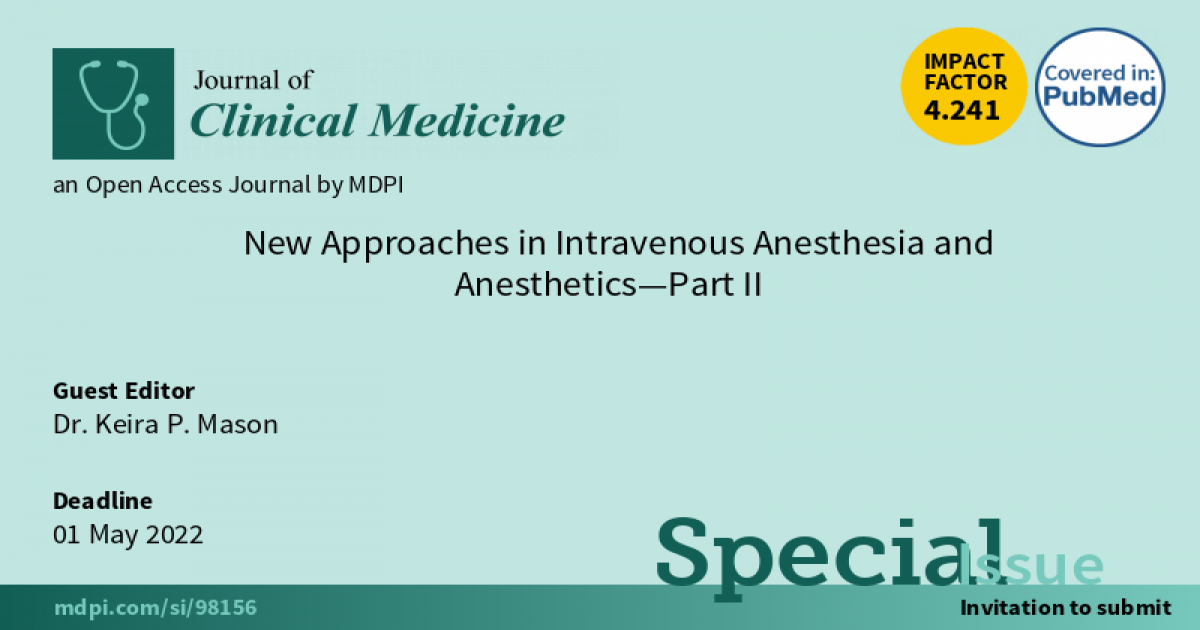New Approaches in Intravenous Anesthesia and Anesthetics—Part II
A special issue of Journal of Clinical Medicine (ISSN 2077-0383). This special issue belongs to the section "Anesthesiology".
Deadline for manuscript submissions: closed (1 May 2022) | Viewed by 42069

Special Issue Editor
Interests: anesthesia and safety outside the operating room; dental sedation; sedation; target-controlled infusion (TCI)
Special Issues, Collections and Topics in MDPI journals
Special Issue Information
Dear Colleagues,
In August 2020, our Special Issue "New Approaches in Intravenous Anesthesia and Anesthetics"—Part 1” was launched (https://www.mdpi.com/journal/jcm/special_issues/Intravenous_Anesthesia). A large number of manuscripts about different topics related to anesthesia have been published. Part I of the Special Issue includes manuscripts focusing on pharmacokinetics and pharmacodynamics of sedative anesthetics, important findings on opiate use and surgical practice, recent developments in sedation in the pediatric intensive care unit, and state-of-the-art intraoperative neuromonitoring in children.
Given the enormous success of Part I, I believe that it is time to move forward to Special Issue Part II, collecting additional insight into anesthesia and anesthetics. For Part II, we are very keen to attract a global audience, welcoming any contributions on this subject from around the world.
We particularly welcome papers providing insight into:
- Pharmacokinetics and pharmacodynamics of sedatives and anesthetics;
- Recent developments in perioperative care;
- Future insights into anesthesia practice over the next decade
We welcome both solicited and unsolicited submissions that will contribute to our goal.
For any and all questions please feel free to contact me at [email protected].
Dr. Keira P. Mason
Guest Editor
Manuscript Submission Information
Manuscripts should be submitted online at www.mdpi.com by registering and logging in to this website. Once you are registered, click here to go to the submission form. Manuscripts can be submitted until the deadline. All submissions that pass pre-check are peer-reviewed. Accepted papers will be published continuously in the journal (as soon as accepted) and will be listed together on the special issue website. Research articles, review articles as well as short communications are invited. For planned papers, a title and short abstract (about 100 words) can be sent to the Editorial Office for announcement on this website.
Submitted manuscripts should not have been published previously, nor be under consideration for publication elsewhere (except conference proceedings papers). All manuscripts are thoroughly refereed through a single-blind peer-review process. A guide for authors and other relevant information for submission of manuscripts is available on the Instructions for Authors page. Journal of Clinical Medicine is an international peer-reviewed open access semimonthly journal published by MDPI.
Please visit the Instructions for Authors page before submitting a manuscript. The Article Processing Charge (APC) for publication in this open access journal is 2600 CHF (Swiss Francs). Submitted papers should be well formatted and use good English. Authors may use MDPI's English editing service prior to publication or during author revisions.
Keywords
- sedation
- safety
- intravenous
- target controlled infusions
- adverse events
- future
- regional anesthesia
Benefits of Publishing in a Special Issue
- Ease of navigation: Grouping papers by topic helps scholars navigate broad scope journals more efficiently.
- Greater discoverability: Special Issues support the reach and impact of scientific research. Articles in Special Issues are more discoverable and cited more frequently.
- Expansion of research network: Special Issues facilitate connections among authors, fostering scientific collaborations.
- External promotion: Articles in Special Issues are often promoted through the journal's social media, increasing their visibility.
- e-Book format: Special Issues with more than 10 articles can be published as dedicated e-books, ensuring wide and rapid dissemination.
Further information on MDPI's Special Issue polices can be found here.






